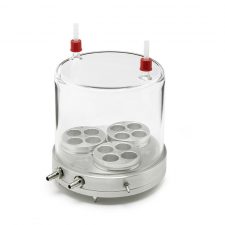On a hot summers day, you can’t beat a big scoop of ice cream – favoured friend of the hot and sweaty, and of the heartbroken! Unless you can eat it pretty fast though, you’re going to experience a sad moment at some point when it starts melting everywhere.

We heard about some scientists in Japan, at the Biotherapy Development Research Center Co., in collaboration with the Kanazawa University who have a cool solution to this age-old issue (pun TOTALLY intended – sorry!). Their ingenious addition to the mix is a polyphenol liquid which is sourced from strawberries. This slows down the melting process enough that the first drips don’t appear for around five minutes, even on a gorgeous hot day!
“Polyphenol liquid has properties to make it difficult for water and oil to separate,” enabling ice cream to stay intact longer, Tomihisa Ota, president of the company and professor emeritus of pharmacy at Kanazawa University, told Japanese daily newspaper Asahi Shimbun.
This discovery was actually kind of a happy accident, it seems, as they’d hired a chef to create a new type of confection using the polyphenol. The chef realised that cream hardened when it came into contact with it so Ota and colleagues tested polyphenol-rich ice creams under the heat of a hair dryer and found that they retained their original shape after a full five minutes of blasted heat! The research centre’s idea has attracted solid commercial interest (understandably!) and melt-resistant ice creams are already on the streets of the Japanese cities of Osaka and Tokyo.

Image Credit: Biotherapy Development Research Centre, Japan.
It doesn’t stop there though! Columbian researchers, Robin Zuluaga Gallego and Jorge A. Velásquez Cock, joined scientists from the University of Guelph in Canada to discover what would happen if they added fibres from banana plant waste to an ice cream recipe. By taking cellulose nanofibrils (thinner than a human hair and derived from banana waste) and grinding them into an ice cream mix this also slows down the melting process. According the press release on the study, the fibres may replace the fats, improve the creaminess and the texture of the ice cream. A more palatable, healthier ice cream with a longer shelf life too – there doesn’t seem to be a down side!

I wonder how long before we find these elsewhere in the world? Have you tried either of them? We’d love to know how they are so please Tweet us @Asynt! We love the way that these teams have thought outside of the box, and moved aside the conventional. We have a practise at Asynt that we call “Asyntise” which embraces this philosophy. Our chemists can work with you to find new solutions to your laboratory issues – drawing upon our considerable engineering and manufacturing resources in addition to knowledge of chemistry theory and practise.
In the meantime, we have plenty of option for cooling things down in the lab! We kept some of our own ice cream in a DrySyn SnowStorm MULTI which was very effective – but I’m sure you could put it to far better use for some actual chemistry! (Note: obviously we used a clean DrySyn SnowStorm that had never come in to contact with work in a lab – please do not try this in your lab!).
 If you’re going for a bigger scale than this for your ice cream manufacturing then how about your own liquid nitrogen generator? Very handy! Please feel free to share if so; our favourite flavour is salted caramel…just FYI!
If you’re going for a bigger scale than this for your ice cream manufacturing then how about your own liquid nitrogen generator? Very handy! Please feel free to share if so; our favourite flavour is salted caramel…just FYI!







